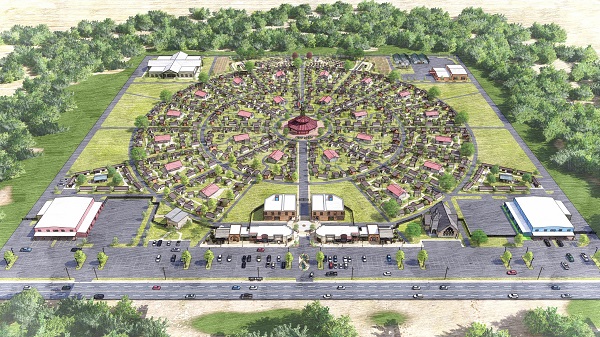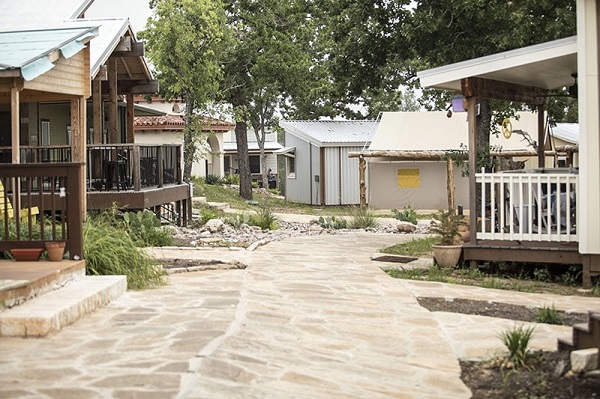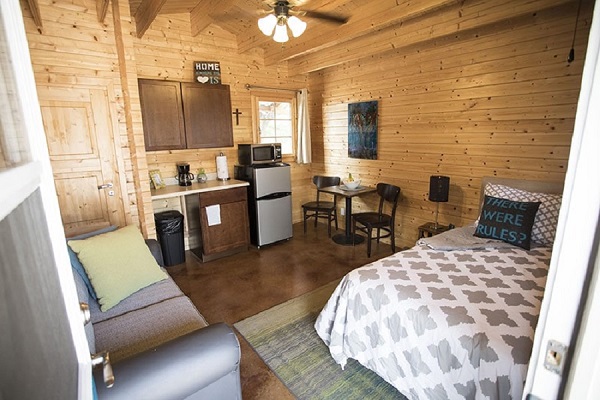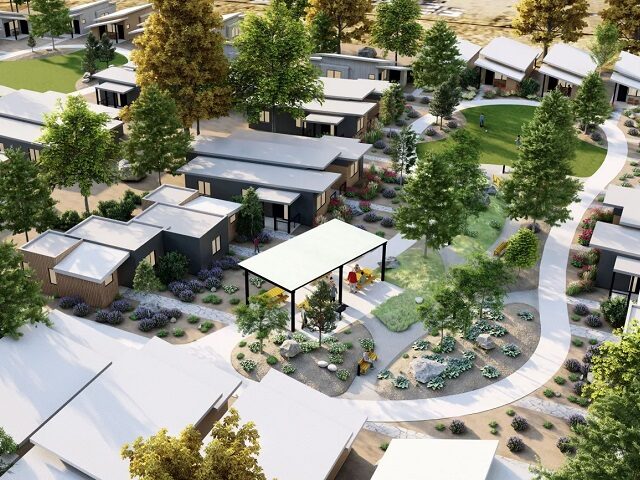The Salt Lake City Council voted Tuesday night to approve a land lease that will pave the way for the construction of a village of affordable tiny homes. The village will provide a cost-effective means of proving housing to the homeless population of the city. The project is modeled after an already successful program in Austin, Texas.
The lease approved by the city council this week will enable The Other Side Village to begin construction of a village of tiny homes on the west side of Salt Lake City, the Salt Lake Tribune reported. The council voted 6-1 in favor of the project.

An artist’s aerial view of the master-planned community aimed at addressing Salt Lake City’s homeless problem. (Salt Lake City Mayor’s Office)
Mayor Erin Mendenhall reacted to the vote, saying, “I can’t wait to welcome the residents to their new homes as soon as we can.”
The Other Side Academy, a non-profit group leading the project, plans to build 54 homes for the purpose of providing affordable housing to the chronically homeless and six for staffers, the local newspaper reported. An additional 25 units will be built as revenue-generating rental homes for visitors, volunteers, and the general public.
The 86 homes on the eight-acre plot of land set for the pilot project will range in size from 280 to 400 square feet. They will include a bed, bathroom, and living area.
The Other Side Village spokesman Samuel Grenny told Breitbart Texas the homes will cost about $75,000 on average. “We hope to get building permits quickly and be housing residents by the summer of 2023.”
The homes will be built mostly by charitable donations and in-kind contributions, Grenny said durning a phone interview with Breitbart. “The residents will pay between $250 and $400 per month in rent, depending on the size of the home.” To pay this, the chronically homeless will have opportunities to work within the grounds of the village. The village will have community gardens, a dog wash facility, a bodega that could eventually grow to a full-service grocery store, and other businesses to provide employment opportunities. “All businesses in the village will be encouraged to employee residents,” he added.
The Other Side Academy intends to fund the initial $13.8 million project through donations and in-kind contributions. The Utah Homelessness County also voted to provide additional funding of $4 million received from federal COVID-19 relief funds.
Earlier this year, Maurice “Moe” Egan, director of neighborhood development for The Other Side Village, told ABC4, “We want to get the American dream back on the table for folks right now are on the streets, chronically homeless, in resource centers, and in encampments.”
In a written statement, Mayor Mendenhall celebrated the moving forward of the project to find a positive and cost-effective alternative for the chronically homeless.
This is a huge step forward in this project. We’re moving at light-speed here, given the scope and urgency of the challenge, and I think that’s a testament to the commitment of the City and our partners to confront the reality of this issue. In The Other Side Academy we have a partner that is devoted to the success and empowerment of its current students. They have a proven track record of successfully managing a peer-based community while being an asset to their neighborhood and this City. And I know that devotion and passion for success will carry over into their work on The Other Side Village.
…
The goal in my 2021 plan was to have tiny homes in place by this upcoming winter. Getting an operator and manager on board as a partner was one of the biggest milestones to meeting that goal, so I’m pleased to have reached this place so quickly. Really, without a service management partner, as optimistic about the concept as we are, a tiny home community would be impossible.
Grenny said the village will be drug and alcohol-free and residents will be subject to random drug testing. He said there will be a transition living area as new residents come off the streets where they will have access to detox and rehab treatment options before moving into the homes. “We call this our neighborhood prep school,” he stated. “During the two to six month transition period, the future residents will learn the culture of the community.”
“Mendenhall’s administration pushed the plan as a way to reduce the cost of public care for unsheltered residents, free up shelter space, create a path to secure housing, spruce up a vacant piece of land and encourage additional development,” the Tribune reported.
Grenny explained the goal is to provide “permanent, supportive housing” to the formerly homeless people. “They will be able to rent here as long as they want, but we anticipate many will graduate to other housing and employment opportunities as they get back on their feet.”
The project’s construction costs will be funded mostly by private funding. Grenny added that they will receive some grants from federal programs administered by the state and local authorities.
As the project achieves success, it will be able to grow to about 430 homes taking up approximately 40 acres.

A neighborhood of tiny homes at Community First! Village in Austin, Texas. (Community First! Village/Mobile Loaves & Fishes)
The Other Side Village is modeled after a similar project in Austin, Texas, which announced plans this week to expand its own Community First! Village with the addition of 1,400 more homes on a 51-acre site, the Austin Monitor reported. The project currently houses 221 people in the village designed to provide housing to the formerly homeless in the Texas capital city. Plans call for the Community First! Village to grow to nearly 180 acres.

An example of an interior view of a tiny home manufactured by Texas-based Practical Revolution for Community First! Village in Austin. (Major Susan Cotter)
Texas-based Practical Revolution — a tiny home developer and manufacturer — builds residential and transitional tiny homes for projects like these. Practical Revolution Owner Joseph Basel told Breitbart Texas, “What Alan Graham and his team have done here in Austin changes everything, every single community leader, government official, and donor from across the country that I’ve taken to Community First is completely blown away by how healthy and inspirational it is.”
“My homeless friends, many of whom are on the edge of suicide, that tour the village are inspired to get healthy,” Basel continued. “One friend was so fired up from realizing he might get in, that he sobered up and is back home in Mississippi welding in his family’s shipyard. Never even moved in. That’s the power of what they are doing at Community First.”
“Alan and Community First are what inspired us at Practical Revolution to start helping other communities to replicate the model and for us to begin manufacturing our lines of instant housing and tiny homes,” he concluded.

COMMENTS
Please let us know if you're having issues with commenting.